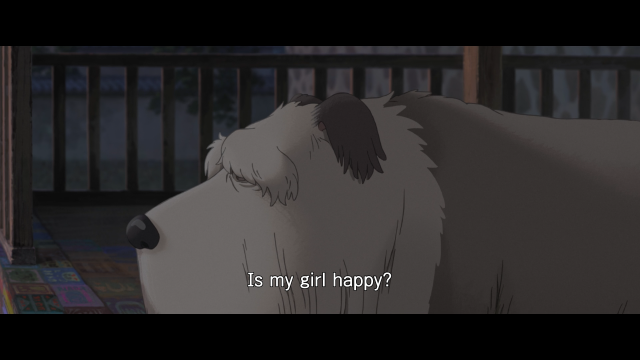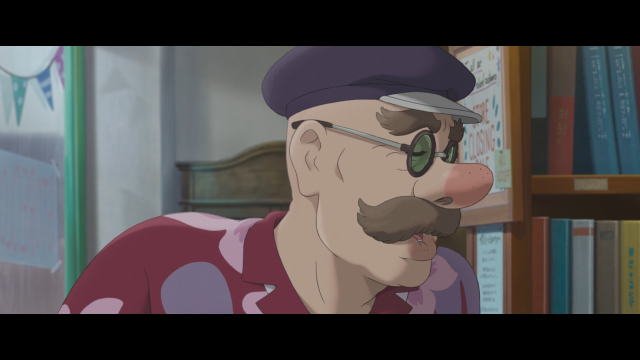originally posted at https://canmom.tumblr.com/post/751772...
Studio Ponoc! They’re like Ghibli but not! We met them a while back on Animation Night 151, wherein I described them like so:
In the mid 2000s, the period that Ghibli could enjoy an exceptional state of employing lot of full-time salaried staff (instead of per project freelancers) was coming to an end. In 2014 it seemed they were on the verge of shutting down altogether. Yoshiaki Nishimura, lead producer of many of Ghibli’s films in the 2000s era (Howl - When Marnie Was There), left the studio in 2015, bringing in a bunch of ex-Ghibli animators under a new studio called Ponoc.
We watched their wonderful short film collection Modest Heroes - notable for the absolutely incredible animation tour de force Invisible in which Akihiko Yamashita shows us a salaryman who becomes so disconnected from society that he becomes invisible and insubstantial…
Ponoc has since become a kind of companion studio to Ghibli, maintaining close relationships with its parent. Their films definitely inherit a lot of both the style and the incredible animation skill accumulated there.
This latest film is directed by Yoshiyuki Momose, whose Ghibli career dates alllll the way back to Grave of the Fireflies - he was basically Isao Takahata’s right hand man, the guy who did the drawings to translate Takahata’s vision into film. As well as working on just about all of Takahata’s films and many of Miyazaki’s, he personally directed three uniquely styled music videos for Capsule, discussed in this article by Animation Obessive. (for some reason the embeds broke)
They are totally differen than anything you’re used to seeing from Ghibli, and it will be fascinating to see if Momose can carry on that spirit! Momose is also known for directing the animated segments of the Ni no Kuni games.
So what’s The Imaginary about? Adapting a book from 2014, it’s about a world where the imaginations of children - their tulpas if you prefer! - come into a kind of independent existence, but face the existential dread of one day being forgotten. Rudger, the creation of a girl Amanda, runs from his fate and finds his way into a lost village of forgotten imaginations. After that… who knows?
Here’s a trailer!
I don’t have a ton of time so I gotta leave it at that for now, but I’ll give a fuller context after the film.
so this movie was preddy good in fact!
the tone of the sakugabooru watch thread was v much ‘this is going to traumatise the hell out of the kids, nishimura really said fuck them kids’. which well. there are multiple character deaths, including one that’s pretty much a gunshot. the villain is doing a lot of this…


There’s a lot of existential horror to the condition of the Imaginaries, who are constantly faced with the prospect of annihilation through forgetting, or at best having their entire personalities overwritten if a new child should adopt them. The film is full of some fascinatingly freaky designs, like this chuuni-ass cat…

or this leggy gramophone

along with some delightful names…

Mr Bunting straight up has Sadako following him around, representing his corrupt imagination…

But I actually love these aspects. While the book here is a lot newer than most British children’s lit of its ilk, the weird and sinister energy is what makes that whole genre compelling.
This is, fundamentally, a kind of ‘child coming to terms with grief through interaction with a magical world’ type of story, in the vein of A Letter to Momo (Animation Night 139) or My Father’s Dragon (Animation Night 142). Unlike those films, the focus is not on the child herself, but on the imaginary friend she creates - Rudger (notably not Roger, this is a plot point) ends up facing immanent disappearance when she is put in a coma after a car accident and strives for most of the film to find a way to get back to her.
In this film, the Imaginaries - once their original creators no longer have need of them - have access to a kind of collective-unconscious world in the form of a library in which they can find work acting in the imaginary scenes of various children. This arrangement is a little tenuous, supported by a mysterious infrastructure in which photographs of children act as a kind of ticket out into the world. Imaginaries are born, it seems, from moments of need and trauma - grief over losing a parent, a scary encounter with a snake.
For me, a story about children and imaginary friends which exist to sooth their pain can only call to mind Umineko and its ‘furniture’ and ‘witches’. Here, as well, the doubt of the adults is at issue - in this world, maturity means forgetting your Imaginary, a process that is presented as natural and inevitable, as sad as it may be for those Imaginaries. The world is not quite so cruel here as in Umineko, but the Imaginaries still face death, and many of them are defined by loss…


…as seen in characters like Fridge the tired old dog, who still mourns the life he had with Amanda’s mum. More sinister, when one of the Imaginaries is killed by Bunting, she is pretty much erased from memory of the other characters. This is a film that is not shy about confronting its characters with serious loss.
The names are really wacky in this film, incidentally. Amanda’s family name is Shuffleup, her granny is called Downbeat, the villain is Mr Bunting. It’s kind of great, definitely adds to the sense of the sort of a surreal, slightly off version of the UK where people speak Japanese but still often write in English for some reason.
I wasn’t entirely convinced by the soft shading style in the trailers, but it’s definitely better in motion, with the chalky texture more visible. there’s absolutely incredible character animation throughout this movie. some highlights are multiple minutes solo-animated by the mighty Shinji Hashimoto, who provides the most spectacular sequences when the line between the real and imaginary worlds starts to blur, but throughout there’s tight-as-hell character animation, spectacular effects and so on.
Anyway, let’s talk about Bunting!
Mr Bunting is the villain who drives this film. His design, in classic Ghibli villain fashion, emphasises the physicality of his face, particularly his twitching, red nose…

Although he’s never framed in explicitly sexual terms, and indeed the character is primarily concerned with ‘eating’ Rudger to sustain his dying imagination, everyone pretty much instantly grasped the sense that ‘this guy is a child predator’. It’s conveyed through the imagery. I’m reminded of the first episode of Paranoia Agent. It’s interesting to me because like… it’s not actually like there is any real basis for this kind of visual shorthand right? As if child abuse is only committed by ugly people?
Anyway, Bunting actually in the internal logic of the film, represents an adult who refused to give up their Imaginary - and to sustain it, he goes around consuming the Imaginaries of other people, magically sustaining his own life. He boasts that all that he has seen gives him enormous power in the Imaginary realm, but in fact his imagination seems to be highly limited to realistic industrial and military imagery.



But later he turns into a torpedo with little arms in a kind of adorkably squash and stretchy way.


Bunting can also just straight up conjure an Imaginary gun, which leads to the death of one of the secondary characters, Emily, a v strong ‘damn I never thought they’d go there’ moment. He’s a weird character but a compelling villain.
Bunting’s demise ultimately comes from accidentally consuming his own, ‘rotten’ Imaginary - she intervenes to save Rudger by self-sacrifice. This reverses the de-aging and he turns to dust. By this point, Amanda’s mother has been drawn into the Imaginary world and reunited with her own Imaginary, but it doesn’t seem set to last - Rudger has now resolved to move on from Amanda.
What exactly can we read Bunting as representing, tho? Lots of readings, I’m sure, but one easy one - an imagination that constantly swallows up the novel and original imaginations of young people just to sustain itself - is suggestive of, say, the undead media franchises of the present. Or you know. A million other things.
But it’s a pretty bleak worldview isn’t it? That you must inevitably let go of ‘imagination’ to join adult society, that this is sad but necessary, and the only way to avoid that is to become a kind of grotesque ghoul absorbing it from others in a zero-sum game. It seems kind of ironic in a movie made by adults that’s there to, presumably, inspire and stimulate the imagination of children with a bunch of appealingly realised images.
The final sequence is pretty fascinating actually. Rudger almost gets rewritten by a new child’s imagination, presented in this context through forcefem imagery, and he spends most of the dénouement running about in a dress…

…which is a great choice. Why not.
Overall, this was a way cooler movie than I thought it would be. It really flopped at the box office - I guess it was harder to put a movie like this across without the Ghibli name attached to it - and definitely it is a kinda weird movie, sitting awkwardly in a space between a movie aimed at kids and aimed at adults. Somehow it doesn’t get the imagery across as effortlessy as Miyazaki can. But there’s a lot of fascinating stuff in here, reminiscent of films like Catnapped! - definitely worth taking a look.
Comments